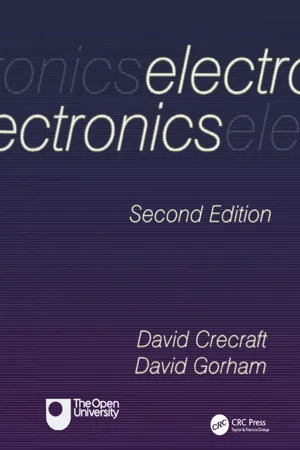
This is a test
- 448 pages
- English
- ePUB (mobile friendly)
- Available on iOS & Android
eBook - ePub
Electronics
Book details
Book preview
Table of contents
Citations
About This Book
Providing an introduction to good engineering practice for electrical and electronic engineers, this book is intended for first- and second-year undergraduate courses. It deals with engineering practice in relation to important topics such as reliability and maintainability, heat management and parasitic electrical effects, environmental influences, testing and safety. The coverage encompasses the properties, behaviour, fabrication and use of materials and components used in the fields of computing, digital systems, instrumentation, and control. The second edition has been revised extensively to reflect advances in technology, with new material on insulation-displacement jointing and electrical-safety testing.
Frequently asked questions
At the moment all of our mobile-responsive ePub books are available to download via the app. Most of our PDFs are also available to download and we're working on making the final remaining ones downloadable now. Learn more here.
Both plans give you full access to the library and all of Perlego’s features. The only differences are the price and subscription period: With the annual plan you’ll save around 30% compared to 12 months on the monthly plan.
We are an online textbook subscription service, where you can get access to an entire online library for less than the price of a single book per month. With over 1 million books across 1000+ topics, we’ve got you covered! Learn more here.
Look out for the read-aloud symbol on your next book to see if you can listen to it. The read-aloud tool reads text aloud for you, highlighting the text as it is being read. You can pause it, speed it up and slow it down. Learn more here.
Yes, you can access Electronics by David Crecraft in PDF and/or ePUB format, as well as other popular books in Technologie et ingénierie & Ingénierie de l'électricité et des télécommunications. We have over one million books available in our catalogue for you to explore.
Information
D.C. circuits and methods of circuit analysis | 1 |
AIMS
The aims of this chapter are
1. To revise some of the basic concepts of direct-current (d.c.) electrical circuits.
2. To explain measurements of voltage and current.
3. To introduce some methods for the analysis of d.c. resistive circuits, and to develop familiarity with, and confidence in, their use.
When you have completed your study of this chapter you should have achieved the following ]objectives.
GENERAL OBJECTIVES
1. Understand the meaning of, and use correctly, the following terms:
• accuracy (of a meter)
• ammeter
• ampere
• charge
• conductance
• conductor
• current divider
• electrical energy
• electrical power
• electrical resistance
• electromotive force (e.m.f.)
• equivalent circuit
• equivalent resistance
• insulator
• internal resistance
• linear resistor
• non-linear resistor
• ohm open circuit voltage
• parallel connection of resistors
• potential difference
• potential divider
• power dissipation
• resistance
• sensitivity (of meter)
• series connection of resistors
• series resistors
• shunt resistor
• siemens
• temperature coefficient of resistance
• variable potential divider (pot)
• volt
• voltage divider
• voltmeter
2. Understand, and be able to explain to someone else, what is meant by the terms ‘circuit analysis’ and ‘network analysis’.
3. Understand the meaning of and use correctly the following terms:
• branch
• common connection
• duality
• earth (ground) connection
• ideal current source
• ideal voltage source
• internal resistance
• Kirchhoff’s current law
• Kirchhoff’s voltage law
• linear device
• loop
• mesh
• nodal analysis
• node
• Norton equivalent circuit
• principle of superposition
• reference node
• Thévenin equivalent circuit
Specific Objectives
1. State the formulae relating, and perform simple calculations involving, the electrical quantities: charge, current, voltage, resistance, conductance, power and energy.
2. State and use the formulae for the equivalent resistance and/or equivalent conductance of resistors in series and in parallel.
3. Use the voltage and current divider rules to calculate voltages and currents in simple circuits.
4. Explain how a basic meter movement may be converted to a multimeter capable of measuring current, voltage and resistance over a wide range of values.
5. Calculate the effect on a simple circuit of connecting an ammeter into it or connecting a voltmeter across a component of it.
6. Give a formal statement of Kirchhoff’s current and voltage laws and use them to develop the current law and voltage law equations for a circuit.
7. Explain the use of a Thévenin equivalent circuit and a Norton equivalent circuit to represent a voltage source.
8. Use Thévenin’s and Norton’s theorems to calculate the equivalent circuit of a network.
9. Use the principle of superposition to calculate the Thévenin and Norton equivalent circuits for a circuit containing multiple voltage and/or current sources.
10. Describe the sequence of steps which constitutes the method of nodal analysis.
11. Use the method of nodal analysis to develop the set of simultaneous equations which allow evaluation of the node voltages.
12. Use a CAD package to analyse a range of d.c. r...
Table of contents
- Cover
- Half Title
- Title Page
- Copyright Page
- Table of Contents
- Preface
- Symbols used in this book
- SI units and abbreviations
- 1 D.C. circuits and methods of circuit analysis
- 2 Signals, waveforms and a.c. components
- 3 Phasor analysis of a.c. circuits
- 4 Amplifiers and feedback
- 5 Combinational logic circuits
- 6 Sequential logic circuits
- 7 Analogue-digital conversion
- 8 Diodes and power supplies
- 9 Basic transistor circuits
- Index